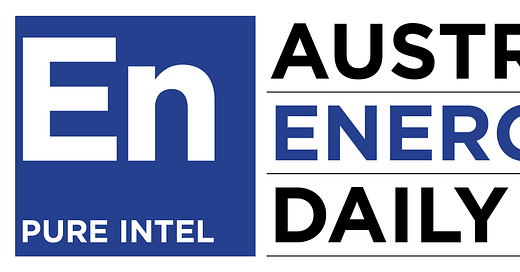Day 75: 'Secure domestic gas supply'
An introductory weekday newsletter from Schwartz Media. Counting the days since Australia had an energy policy.

Good morning and welcome to day 75.
Today in summary: Government-owned Snowy Hydro aims to cut retail power prices by fuelling itself with renewables, not coal and gas; Queensland releases another 6600 square km for gas exploration, with some earmarked for domestic use; and Germany makes further moves towards its 65% renewables target by 2030.
— Sophie
Today’s policy spin level: 💨💨💨
Please don’t keep Australian Energy Daily to yourself. Forward this email to your colleagues and encourage them to sign up for free here.
Federal government-owned Snowy Hydro will buy 888 megawatts of solar and wind power from eight new plants to fuel its pumped hydro storage generators, and says the move to renewables will help cut retail power bills. Snowy has used coal or gas to pump the water it needs for its hydro cycle, and the move will enable it to offer supply contracts at less than A$70/megawatt hour from the start of 2020, compared to the current market offers of A$98.50/MWH in NSW and $108/MWH in Victoria.
Queensland is releasing more than 6600 square kilometres of new land for gas exploration, with 900 square kilometres reserved to supply the Australian market. The state’s resources minister, Dr Anthony Lynham, said the release was the fourth since February 2017 and the land - located south-west of Chinchilla in the Bowen and Surat basins - is “perfectly placed for companies wanting to hit the ground running”.
“A secure domestic gas supply is on everyone’s lips right now, and Queensland continues to do the heavy lifting, releasing more land for exploration and putting the right policy levers in place to encourage investment.”
Germany’s government has approved a green energy plan which will auction an extra 8 gigawatts of wind and solar power from 2019 to 2021, as the country aims to have 65% of its power from clean sources by 2030, Bloomberg reports. Germany’s clean power share has jumped from below 10% in 2002 to nearly 40% in 2017, after renewable subsidies began in 2000.
Coming up
The Competition & Customer Experience in Energy conference will be held in Melbourne on November 13th and 14th. Speakers include the Australian Energy Regulator’s Sarah Proudfoot and Tony Robinson, chair of the Ausnet Services Consumer Forum.
The Commentariat
The US should hook its supply of natural gas up to the world market to lift prices and keep producers happy, writes Dr James Conca for Forbes. LNG prices in the US are much lower than world standards and that’s hurting the industry, though it has been predicted that the US could become the world’s largest LNG exporter within two years, behind Australia and Qatar.
“The industry’s savior may well be connecting to the global market… This is good news for Europe and bad news for Russia, who has been using its dominant gas supplies as a predatory weapon.”
Three more things
The US Oil and Natural Gas Subsector Coordinating Council is standing its ground against claims from Trump administration agencies that natural gas pipelines are vulnerable to cyber attacks. The government’s claims are ostensibly part of wider efforts to enhance the resilience of the grid, but many in the industry view these efforts as providing a lifeline to uneconomic coal and nuclear power plants under the cloak of cybersecurity concerns.
A report from the World Bank has found that global capacity of floating solar plates reached 1.1 gigawatts at the end of September 2018 - the same gigawatt capacity reached by ground-mounted solar panels in 2000. Besides predicting a future decrease in cost of the technology, the report finds that installation of floating solar at hydropower dams would boost the energy yield of those assets as well as assisting in generation during periods of low water availability.
Australia’s first solar and battery powered portable classroom has hosted its first class at Bracken Ridge State High School in Brisbane. The renewables-powered portable classroom is the result of a public-private partnership between the Australian Renewable Energy Agency and Hivve Technologies, and was developed in collaboration with Tesla. Hivve classrooms generate enough electricity to power themselves and a minimum of two other classrooms, while using battery storage technology to store excess power.


